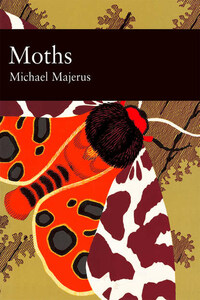There are many things that this book is not. It is not a book about moth collecting. It is not a book about how to identify moths. It is not a book about how to study moths. But it is a book about moths: about their lives, their behaviour, their struggles to survive and reproduce within a hostile environment, their multitude of enemies, their extraordinary capabilities in avoiding them, and their future in the face of human-driven change. It is also a book about their beauty.
I was incredibly flattered when I was asked to write this book. I have been a fan of the New Naturalist series since I was ten and a fan of E.B. Ford for just as long, for it was on my tenth birthday that I was given a present of Fordâs Butterflies. To emulate Ford in writing two books for the New Naturalist series I felt was a great honour. However, I only accepted this undertaking after considerable thought and with some trepidation.
I think it necessary to make it clear that this book is neither a revision nor simply an updating of Fordâs wonderful New Naturalist Moths. Indeed, although professionally my field of expertise is that of ecological genetics, a field of science that Ford founded, I have tried to avoid the basic genetical ground covered in Fordâs Moths. This is largely because the fundamentals of genetics described so clearly by Ford nearly half a century ago have changed little, and I would still recommend anyone with an interest in the way that characteristics of moths are inherited to read Fordâs two books, Butterflies and Moths.
This book is concerned more with the place of moths in the biological world. It is thus a book on the natural history of moths, dealing with their behaviour, ecology and evolution. The first chapter introduces the subject of moths, discusses human perceptions of them and describes how they are related to what most people would recognise as the other group of the order Lepidoptera, the butterflies. Chapter 2 describes the basic life cycle of moths, treating each of the four major stages separately while showing how they fit together in the overall cycle from generation to generation. In Chapter 3, the basic processes of evolution that have moulded and continue to mould moths are discussed.
Chapters 4-8 consider how moths live their lives, in a context of their interactions with one another and the rest of their environment. The backdrop of these chapters is a very simple equation that is relevant to all populations of all organisms. It is simply that changes in population size depend on the birth rate, the death rate and any migration into or out of the population. Chapter 4 deals with reproduction and all that that entails, from sex determination through the various and complex aspects of courtship and mating to the point when females finally lay their eggs. Chapter 5 follows the life cycle through the main feeding stage, the larval stage, to the pupa and finally the adult. Here host plant preferences and habitat specialisations are considered. The adult theme is continued in Chapter 6 with a consideration of mothsâ flying abilities, their dispersal, migration and distributions. Death rate is considered in Chapter 7, in which the various biotic enemies of moths, including man, and other causes of moth death, are described. Chapter 8 tells the other side of the story in a discussion of the many and various survival traits that moths have evolved to foil those that would make a meal of them.








